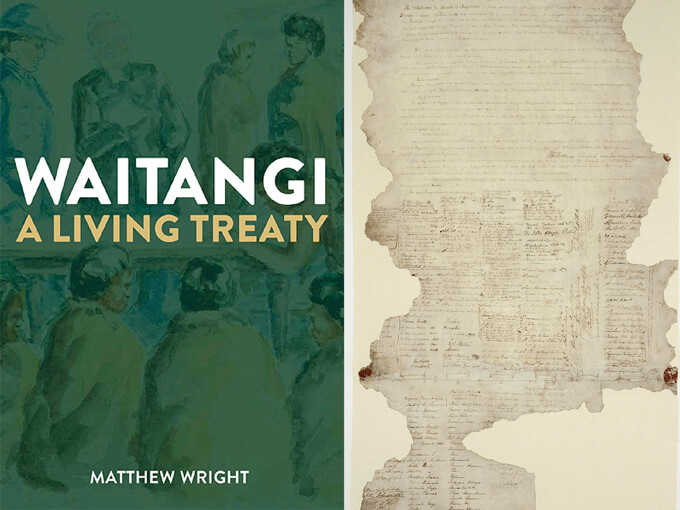Aug 30, 2019 Books
How should the Treaty of Waitangi, with its multitude of meanings, shape our future? A new history provides plenty of information, but no “final word” on the questions it raises.
In the foreword of Waitangi: A Living Treaty, Paul Moon paraphrases Rudyard Kipling and asks, “And what should they know of the Treaty who only the Treaty know?” It’s a fair question. What is the Treaty of Waitangi? Is it a national founding document? A binding agreement between two peoples? An expression of good faith? A trap? A relic? A ruse? A fraud? Does it give Maori preferential treatment or is it the tool by which Maori were subjugated? Is it an extension, a replacement, or a partner of He Whakaputanga (the Declaration of Independence signed by northern chiefs in 1835)? Is it a historical artefact or a continuing imperative? Is it law? Should we follow the literal text or its so-called ‘principles’? Should we follow it at all? If we do, which version? Which language? Which translation?
The questions as to what the Treaty is and what that means for us are seemingly endless and the answers are often multitudinous, even in spaces where we expect simple, straightforward facts. In Te Tiriti o Waitangi, an accessible comic-book history illustrated by Toby Morris, recently released as a bilingual text for upper primary students, the Treaty is variously categorised as “an excuse for a day off school”, “one of the most important parts of our country’s history”, a way to control early renegade settlers and protect Maori, and the starting point of widespread colonisation, land confiscation, the New Zealand Wars, and ultimately the Waitangi Tribunal and its settlement process, which helps “Maori to achieve success in all kinds of ways” and “allows authority to be shared and encourages a greater understanding of what happened to Maori”.
As might be expected, or even desired, in a primary school text, Morris’ final analysis of the Treaty is that it’s really about making “a country that is fair for everyone — where all New Zealanders have the same opportunities”. In Waitangi: A Living Treaty, historian Matthew Wright’s answer is just as paradoxically myriad and singular, but, as one would expect from a professional historian, less saccharine and more complex: the Treaty is and means whatever we want or need it to. “In fact the meanings of the Treaty have been evolving for its entire history in various ways… a symbolic expression of everything from national identity to lost hopes.” In this sense, Morris’ comic is just one of the latest in a long tradition of reimagining, reinventing, rediscovering and repackaging the Treaty.
After an introductory “Deep History” of pre-contact New Zealand, Wright engages in a thorough and extensive examination of the signing of the Treaty and the immediate contexts before, during and after, including the local politics involved both here and in Britain, which takes up the first half of the work. However, once we pass this point, both in the book and in history, the Treaty becomes, as it so often does, a totem for a more general discussion of the place of Maori, Maoritanga and Maoridom, in New Zealand, as a state, a geographical area, an idea, an identity, and all such other iterations. In this second half, the reader wanting specifics about the Treaty and its place during this period will, perhaps appropriately, feel their absence, especially in light of the general fullness of Wright’s historical coverage of the “missing” years that fall outside of the New Zealand Wars, Gallipoli, World War II, and other such touchstones of the popular conception of New Zealand’s formative past.
Given Wright’s largely chronological approach, it’s only natural to expect the book to end, like Morris’s comic, by examining the current place of the Treaty and perhaps even the current Treaty process and industry. Instead, in his final chapters, Wright reveals his true impetus. While the Treaty is its subject matter, the book is really about history. Wright protests the distortions history undergoes, whether employed as evidence for or against Treaty claims or ideological stances, potentially ignoring or not seeking out aspects that might work against a case, or being perverted into pseudohistory of the sort that purports to prove pre-Maori European habitation of New Zealand. It seems that Wright, to borrow from Kipling’s words, can no longer “bear to hear the truth [he’s] spoken, twisted by knaves to make a trap for fools” and, being made to “watch the things [he] gave [his] life to broken”, seeks to defend history and historical inquiry purely as “an abstract investigation of past events”.
Read Waitangi: A Living Treaty for information and insight, but not for answers. Wright’s history is neither a final word nor an axe well-ground. In Wright’s own words, “Ultimately, history offers only discussion — and yet that is a useful end in itself. By constructively engaging in collegial dialogue over what is known and by identifying the limits of what can be known, we can learn more about our journey to the present, and so find not just new understanding of ourselves but ways to move forward.”
Waitangi: A Living Treaty
Matthew Wright
Bateman Books, $40
This piece originally appeared in the July-August 2019 issue of Metro magazine, with the headline “Insight, not Answers”
Follow Metro on Twitter, Facebook, Instagram and sign up to our weekly email






